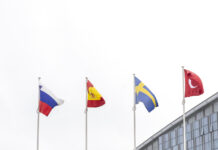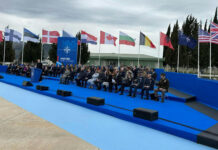As to whether the EU is envisaged as a security institution depends very much on how one defines such a security body in the first place and whether it possesses the relevant tools. On the other hand, from the very beginning, NATO has very clearly been accepted as an international security institution with its well-known Article 5, the so-called “musketeer oath”. Therefore, in order to address the issue, it will be necessary to look at the EU to see if similar criteria apply.
Definition
In this context, a security institution can be defined as an institutional arrangement referring to security measures and protocols mandated by a government or corporate entities. These measures shall be in place to protect strict social structures and the environment. Examples of international security institutions, besides NATO, are the UN Security Council, the North Atlantic Council, the US-Soviet Standing Consultative Commission, and the Board of Governors of the International Atomic Energy Agency (IAEA). The keyword for any security institution is to “protect” and to do so by using the necessary means available.
Considering this, it is important to note a NATO member country’s collective defence obligations according to Article 5 of the North Atlantic Treaty:
“The Parties agree that an armed attack against one or more of them in Europe or North America shall be considered an attack against them all and consequently they agree that, if such an armed attack occurs, each of them, in exercise of the right of individual or collective self-defence recognized by Article 51 of the Charter of the United Nations, will assist the Party or Parties so attacked by taking forthwith, individually and in concert with the other Parties, such action as it deems necessary, including the use of armed force, to restore and maintain the security of the North Atlantic area.
Any such armed attack and all measures taken as a result thereof shall immediately be reported to the Security Council. Such measures shall be terminated when the Security Council has taken the measures necessary to restore and maintain international peace and security.”
This language is relatively flexible. It permits each NATO member country to decide for itself what action it should undertake to react to an armed attack on a NATO ally. It does not require any member to respond with military force, although it permits such responses as a matter of international law. A member may decide that instead of responding with force, it will send military equipment to NATO Allies or impose sanctions on the aggressor. The purpose is to restore and maintain security. In other words, Article 5 is securing maximum protection for NATO members.
EU Lisbon Treaty Article 42.7
The Treaty of Lisbon amounts to another attempt to enhance European security and defence as it introduced the initiative of the Common Security and Defence Policy (CSDP), a policy espousing defence cooperation and coordination between EU Member States whilst creating internal political and military structures that facilitate civilian and military operations outside of the EU. Furthermore, the Treaty of Lisbon introduced several mechanisms, including a commitment to mutual assistance and Article 42.7 is the mutual defence clause. It derives from Article 5 of the Treaty of Brussels in 1948 that created the Western European Union (WEU), the first mutual defence organisation in Europe. Article 42.7 was incorporated into the Lisbon Treaty in 2011 and states that:
“If a Member State is the victim of armed aggression on its territory, the other Member States shall have towards it an obligation of aid and assistance by all the means in their power, in accordance with Article 51 of the United Nations Charter.
This shall not prejudice the specific character of the security and defence policy of certain Member States. Commitments and cooperation in this area shall be consistent with commitments under the North Atlantic Treaty Organization, which, for those States which are members of it, remains the foundation of their collective defence and the forum for its implementation.”
This article was introduced at the instigation of those Member States who supported a greater role for the EU on defence matters. The French were particularly prominent amongst those advocating such an approach. In fact, Emmanuel Macron has outlined how Europe needs to finally become independent because the Russian invasion of Ukraine proves that Europe cannot depend on others. In this respect, European defence must take a new step forward. Here the EUROCORPS might come into play.

Credit: EDA
Requirements
Article 42.7 differs from Article 222 of the Treaty on the Functioning of the EU (the so-called “Solidarity Clause”), which pledges solidarity in the face of terrorism, and from NATO’s Article 5.
At the simplest level, EU Member States are required to provide aid and assistance, although the provisions do not apply equally to all countries. The Article contains the provision that it:
“…shall not prejudice the specific character of the security and defence policy of certain Member States.”
This means that countries with long-standing traditions of neutrality, such as Ireland, Finland or Sweden, are not required to break these traditions. Apparently, an EU mutual defence article exists, but it is linked to commitments in a NATO context and if a country has some specific caveats such as neutrality, that country can abstain from taking part in a given defence activity. Differences still exist between Member States in the interpretation of this article.
NATO-EU Threat Management
While the NATO-EU partnership is simultaneously an indispensable component of, and an emerging framework for, contemporary threat management, it is also confronted with several difficulties that undermine its remit and impact. Some issues are worth mentioning to establish a picture of the EU as a security institution.
Although the NATO-EU Declaration from 10 July 2018, which comes two years after an initial agreement made in Warsaw, states that NATO and the European Union are strengthening cooperation in a range of areas, the two Joint Declarations were issued and signed by the organizations, not by their respective members. The dynamic and degree of political will within Member States can therefore be different. States that belong to only one of the two institutions do not always necessarily see cooperation with the other as a top priority. Indeed, 22 states are members of both institutions, and this facilitates cooperation, yet with the US and Turkey on one side, and some of the non-aligned EU non-NATO states on the other, there are divergences over the idea of a mutually beneficial partnership.
Even among the 22, there are those that are lukewarm about the virtues of cooperation as Article 42.7 states that, “Commitments and cooperation” in defence “shall be consistent with commitments under the North Atlantic Treaty Organization, which, for those States which are members of it, remains the foundation of their collective defence and the forum for its implementation”. The essential partners of NATO prevail in their own security policy, and the other one is consequently less of a priority.
The number of EU entities involved in EU-NATO relations makes the partnership a multi-level exercise rather than a two-player game. The European External Action Service (EEAS), the European Commission (EC), the General Secretariat of the Council (GSC), and the European Defence Agency (EDA) are simultaneously engaged in a dialogue with NATO. And even NATO is not necessarily homogeneous, with entities such as Supreme Headquarters Allied Powers Europe (SHAPE) relating to the EU in a way that may differ from interaction at political headquarters’ level. This creates different layers of dialogue that tend to alter the bilateral nature of the relationship, while the EU internal coordination challenge also complicates cooperation with any third party.
Practically, this means that there can be no review or update of the existing legal arrangements between the EU and NATO outside of the implementation of the 2003 Berlin Plus agreement. Under Berlin Plus, the EU can request NATO to make available its assets and capabilities to the EU for an EU-led and directed operation. To date, the EU has conducted two operations with NATO support. Operation EUFOR Concordia in 2003 in the former Yugoslav Republic of Macedonia (fYRoM) and Operation EUFOR Althea in 2004 in Bosnia and Herzegovina, which is still ongoing.

Under the CSDP, the EU takes a leading role in peacekeeping operations, conflict prevention and the strengthening of international security. It is an integral part of the EU’s comprehensive approach towards crisis management, drawing on civilian and military assets. Since the first CSDP missions and operations were launched back in 2003, the EU has undertaken over 37 overseas operations, using civilian and military missions and operations in several countries in Europe, Africa, and Asia.
Finally, the EU-NATO partnership takes place within the context of the EU’s renewed efforts to develop its own defence policy and the debate which this generates in terms of compatibility with NATO. With the creation in 2017 of the Permanent Structured Cooperation (PESCO) and the European Defence Fund (EDF), the EU has tangibly upgraded its defence profile, which in turn has changed the nature of the EU-NATO dialogue. In principle, the EU defence momentum must enable the EU to better tackle threats in cooperation with, and to the benefit of, NATO. Coordination between the European Capability Development Plan (CDP) and the NATO Defence Planning Process (NDPP) is improving because of PESCO. The NDPP is feeding into the CDP and the two are different by nature. In essence, the NDPP is NATO’s tool to assess member states’ contributions to the forces needed to carry out NATO’s military level of ambition. The CDP has been designed specifically to analyse what sort of military capabilities the EU needs in more general sense and where the major shortfalls lie.
Strategic Concerns
The narrative over the EU’s strategic autonomy, which is sometimes linked to the question of a ‘European Army’ or ‘Army of Europeans’, has also stirred concerns about intended or unintended consequences for NATO and the transatlantic bond. From an EU perspective, an appropriate level of EU strategic autonomy contributes to more effective burden-sharing across both institutions and strengthens Europe’s ability to promote peace and security within and beyond its borders. Yet the fact that the aspiration towards strategic autonomy might reflect a certain mistrust vis-à-vis the Alliance or the US, or that it simply takes stock of a fading US commitment to European security, has also led to some tension. The EU-NATO partnership does not exist in a political vacuum – it is to a large degree a product of political dynamics within each institution, as well as at the transatlantic level. The current tensions within the EU in the context of Ukraine and within NATO about its own internal cohesion can only foster more synergies between the two institutions.
For the EU, it is a question of whether to build a strategy taking three parameters into account; Russia, gas and oil; China, cheap high technology and the Silk Road; and the US, security. For the EU, it will be difficult to navigate in this triangle and we have already seen EU nations following their own path in these areas. It has also been noted that one nation even remarked that NATO was experiencing “brain death”, while others are striving hard to keep NATO and the US closer to the security of NATO and Article 5. In addition to this, two more EU members have signed up for NATO membership.
However, cooperation between NATO and the EU looks set to deepen somewhat, as on 10 January 2023, the two signed a Joint Declaration on EU-NATO Cooperation. This stated that “The NATO-EU strategic partnership is founded on our shared values, our determination to tackle common challenges and our unequivocal commitment to promote and safeguard peace, freedom and prosperity in the Euro-Atlantic area.” The agreement also promised to “assess progress on a regular basis.”
The EUROCORPS
In October 1991, the French, and the German Governments, were keen to increase the discernible signs of the reconciliation between France and Germany while nurturing simultaneously an idea of European defence. Some months later, in May 1992, both Governments decided to establish a French-German Corps Headquarters in Strasbourg, where both nations would have an equal share of the command but also the burden. The EUROCORPS was established.
Shortly after, the French and German Governments decided to open this headquarters to members of the WEU. Today there are 11 Framework or Associated Nations. Currently this might be the closest you come to the tools for a security institution in Europe. But again, when one examines the setting for the EUROCORPS, it is stated, after the creation of the EUROCORPS in 1992, that the Corps is at the disposal of NATO to show to the Allies that the EUROCORPS was not only a new European unit but was also complementary to the defence efforts of the Alliance. Since the signature of the SACEUR agreement in 1993, the EUROCORPS can be placed under the command of SACEUR to develop shared training and planning with NATO.

Credit: NATO
Conclusion
One might wonder why there cannot be a NATO taking care of security and threat management and an EU taking care of trade and trade management. Nevertheless, there is increasing competition between the great powers assuming the form of a global struggle for power and position. The US focus on innovation and technology means that the European NATO member countries and EU are subjected to renewed pressure. The EDF and NATO’s Defence Innovation Accelerator for the North Atlantic – or DIANA – are both working with the private sector and academia, to ensure that they can harness the best of new technology for Euro-Transatlantic security. The result is that taxpayers are paying twice for the same service. Whether this is an intelligent way of doing business, only the future will show. The discussion about the wisdom in having an EU as a security institution will continue and the result might well be that EU Member States that are also NATO Allies are hedging their bets in favour of the Alliance’s better defined defence mandate, rather than that of the EU, whose ambitions for common security and defence remain largely statements of intent. This should be seen in the context of the current security situation in Europe, and Finland and Sweden’s pending accession to NATO.
Bo Leimand











